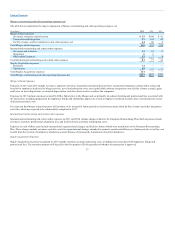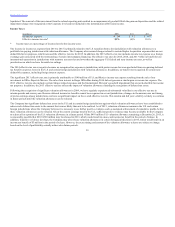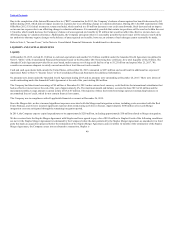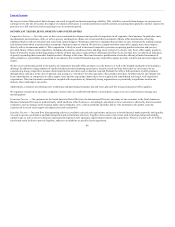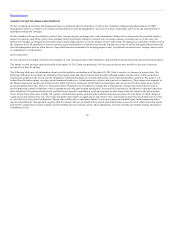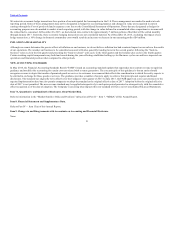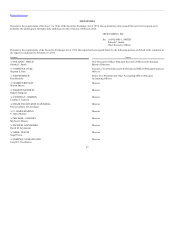OfficeMax 2015 Annual Report Download - page 49
Download and view the complete annual report
Please find page 49 of the 2015 OfficeMax annual report below. You can navigate through the pages in the report by either clicking on the pages listed below, or by using the keyword search tool below to find specific information within the annual report.
Table of Contents
Costs associated with facility closures that are related to Merger and restructuring activities are and, in future periods will be, presented in Merger,
restructuring and other operating activities, net in our Consolidated Statements of Operations. Costs associated with facility closures that are deemed
operational are included in Selling, general and administrative expenses.
Pensions and other postretirement benefits — In addition to an existing but closed defined benefit plan in Europe, the Company assumed responsibility for
certain OfficeMax defined benefit pension plans and retiree medical benefit and life insurance plans. The OfficeMax plans are frozen and do not allow new
entrants. At December 26, 2015, the funded status of our existing and assumed OfficeMax defined benefit pension and other postretirement benefit plans was
a liability of $185 million. Changes in assumptions related to the measurement of funded status could have a material impact on the amount reported. We are
required to calculate our pension expense and liabilities using actuarial assumptions, including mortality assumptions, a discount rate and long-term asset
rate of return. For year end 2015 measurement, we updated North America benefit plans’ mortality assumptions based on tables recently-published by Society
of Actuaries’ Retirement Plan Experience Committee. We do not anticipate changes to those assumptions in the near future. We base our North America
plans’ discount rate assumptions on the rates of return for theoretical portfolio of high-grade corporate bonds (rated AA- or better) with cash flows that
generally match our expected benefit payments in future years. The discount rate for the European plan is derived based on long-term UK government fixed
income yields, having regard to the proportion of assets in each asset class. We base our long-term asset rate of return assumptions on the average rates of
earnings expected on invested assets. Based on current market conditions, for year end 2015 measurements, the discount rate and the assumed long-term rate
of return on plan assets decreased. Currently, the net impact of these plans is an annual credit to income. However, because of the judgments and estimates
included in pension and other benefit valuation, such amount could change in future periods and have a significant impact on our financial position and
results of operations. A 50 basis point reduction in the discount rate would increase the 2016 pension expense credit by $3 million. A 50 basis point
reduction in the assumed long-term rate of return on plan assets would reduce the 2016 net pension credit by $5 million.
Income taxes — Income tax accounting requires management to make estimates and apply judgments to events that will be recognized in one period under
rules that apply to financial reporting and in a different period in our tax returns. In particular, judgment is required when estimating the value of future tax
deductions, tax credits, and the realizability of net operating loss carryforwards (NOLs), as represented by deferred tax assets. When we believe the realization
of all or a portion of a deferred tax asset is not likely, we establish a valuation allowance. Changes in judgments that increase or decrease these valuation
allowances impact current earnings.
The Company has significant deferred tax assets in the U.S. and in certain foreign jurisdictions against which valuation allowances have been established to
reduce such deferred tax assets to the amount that is more likely than not to be realized. As of 2015, valuation allowances remain in the U.S. and certain
foreign jurisdictions where the Company believes it is necessary to see further positive evidence, such as sustained achievement of cumulative profits, before
these valuation allowances can be released. Given the current earnings trend in the U.S., sufficient positive evidence may become available for the Company
to release all or a portion of the U.S. valuation allowance in a future period. Of the $493 million U.S. valuation allowance remaining at December 26, 2015, it
is reasonably possible that $265-$360 million may be released in 2016, which would result in a non-cash income tax benefit in the period of release. In
addition, if positive evidence develops, the Company may also release valuation allowances in certain foreign jurisdictions in 2016, which would result in an
income tax benefit of $3 million in the period of release. However, the exact timing and amount of the valuation allowance releases are subject to change
based on the level of profitability actually achieved in future periods.
In addition to judgments associated with valuation allowances, our current tax provision can be affected by our mix of income and identification or
resolution of uncertain tax positions. Because income from domestic and international sources may be taxed at different rates, the shift in mix during a year or
over years can cause the effective tax rate to change. We base our rate during the year on our best estimate of an annual effective rate, and update that
estimate quarterly, with the cumulative effect of a change in the anticipated annual rate reflected in
47


